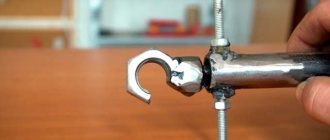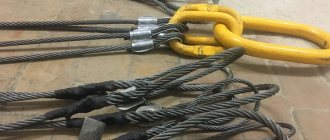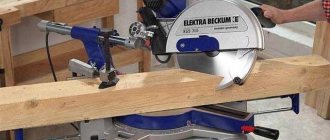Lifting operations pose a great danger to the lives of personnel and people in the work area. Therefore, the first condition for working with lifting equipment and devices is to ensure their safety.
The “Inter-industry rules for labor protection during loading and unloading operations and placement of goods” POT RM-007-98 and other regulatory documents have developed standards and recommendations for the inspection and rejection of all types of removable lifting devices. In this article we will talk about the norms and rules for rejecting chain, rope and textile slings.
Inspection and rejection of slings is carried out by engineering and technical personnel responsible for the serviceability of the equipment and the safety of the work performed. To identify faults, slings undergo external, instrumental and internal inspection, during which the compliance of the slings with their characteristics reflected in the product passport is assessed. The assessment results are reflected in the inspection log, which is drawn up in the prescribed form. The log should also reflect information about the elimination of defects and damage and contain the signatures of the responsible persons.
Norms for rejecting slings
Steel rope slings
Rope slings are produced in accordance with GOST 25573-82 and RF-10-33-93. They must undergo all 3 stages of inspection: external, instrumental and internal. If non-compliance with safety requirements is detected, as well as if damage exceeds the established standards, rope slings should not be allowed to work.
When inspecting rope slings, the main focus is on the following aspects:
- compliance of the sling and the data on the tag with the passport data of the product;
- loops at the end of the rope and their serviceability;
- defects and damage along the length of the rope and their acceptable level;
- condition of the internal strands and core.
In what cases are rope slings subject to rejection?
- Rope slings are subject to rejection if there is no tag or marking on it.
- Wear of outer wires should not exceed 40% of their diameter
- The rope should not be used if the core is torn or squeezed out.
- A rope is subject to rejection if the diameter has decreased by 7% or more with corrosive wear, by 3% or more with a non-rotating rope, and by 10% or more with internal wear and rupture of the core.
- Also in case of deformation, cracks or wear of thimbles with a decrease in thickness by more than 15% and bushings with a decrease in thickness by more than 10%, with damage to braids and other protective elements.
- When there are signs of displacement of the rope in the braid, bushings and clamps.
- If there are protruding ends of the wire in the braided areas by more than half the diameter of the rope.
- The sling is subject to rejection for waviness, if the diameter of the spiral, coinciding with the direction of lay, is 1.08 times greater than the diameter of the rope, and if the diameter of the spiral does not coincide with the direction of lay, then 1.33 times.
- The rope should also not be allowed to work with defects resulting from exposure to temperature or electric arc discharge.
- The number of breaks should not exceed the following standards:
| Number of breaks | Rope length |
| 4 | 3 x rope diameter |
| 6 | 6 x rope diameter |
| 16 | 30 x rope diameter |
Important!
In cases where the wear of the outer wires reaches 30% of the diameter of the rope or, as a result of wear, the diameter of the rope decreases by 5% or more, the above figures are halved.
Chain slings
Chain slings are produced in accordance with PB-10-382-00 and TU3150-001-52466920-2005. Among all slings, chain models have the longest service life - 18 months. Regular inspection of chain slings includes visual and instrumental stages, during which the following are studied:
- tags and markings, as well as their compliance with the product passport;
- serviceability of the connecting elements at the end of the sling;
- diameter and length of chain links and deviations from the original dimensions.
Chain slings are subject to rejection
in the following cases:
- When there is no tag or marking on it.
- For any cracks, ruptures, deformations and delaminations of the metal.
- When the link is lengthened by more than 3%
. - When it decreases by more than 10%
due to mechanical wear and corrosion. - For damage due to gas cutting, welding, electric arc cutting or temperature exposure.
Textile slings
To assess serviceability, textile slings must undergo a visual inspection for compliance of the markings with the passport, serviceability of seams and loops, connecting elements and grips. They must also undergo an instrumental inspection to determine dimensions and defects. If the following deficiencies are identified, textile slings should not be allowed to work.
- If there is no tag or marking.
- If there are knots or transverse breaks on the supporting tapes of the sling, despite their size.
- The length of longitudinal cuts or tears should not exceed 50 mm, and the total length should not exceed 10% of the length of the sling branch.
- In case of local delamination of the tape by more than 0.5 m with a break in three or more lines. And also in case of delamination on the sealing edges of more than 0.2 m and deviations of the edge of the loop with a length of more than 10% of the stitching length.
- In case of surface breaks of the belt, damage from chemicals, as well as single damage measuring more than 10% of the width of the belt.
- With through holes from sharp objects or burns with a diameter of more than 10% of the width of the tape. It is also not allowed to have three or more holes with a distance of less than 10% of the width of the tape.
- When more than 50% of the sling length is contaminated with cement, soil, paints, petroleum products, and so on.
The above points apply to tape
textile slings.
to the rejection standards for round-strand
slings: rupture of the cover, breaks of 6 or more wires, breaks of threads in the stitching unit by 10 percent or more of its length and through holes in the cover.
Multi-leg slings are subject to rejection if there is a difference in the branches due to their elongation. The table shows the minimum permissible residual elongation of the branches of different slings:
| Cable cars | Chain | Textile |
| 3% | 1% | 6% |
REQUIREMENTS FOR SLINGS AND CONTAINERS
The rope sling is subject to rejection if the number of visible breaks in the outer wires of the rope exceeds that indicated in the table. Double lay rope slings
| Sling rope section length | |||
| 3d | 6d | 30d | |
| Number of visible wire breaks in a given area | 4 | 6 | 16 |
Note:
d—rope diameter, mm.
Rejection of sling parts
(rings, loops and hooks) should be made:
- in the presence of cracks;
- when the surface of elements wears out or local dents lead to a decrease in cross-sectional area by 10%;
- in the presence of residual deformations leading to a change in the original size of the element by more than 5%.
In what cases are slings rejected?
Slings that have:
- identification tags are missing or damaged;
- thimbles are deformed or their wear has led to a decrease in the original cross-sectional dimensions by more than 15%;
- there are cracks on the pressed bushings or the dimensions of the latter have changed by more than 10% from the original ones;
- there are displacements of the rope in the braid or bushings;
- braids or other protective elements are damaged or missing if there are protruding ends of the wire at the braiding point;
- hooks do not have safety locks
The following slings are not allowed for use:
- having the defects indicated above;
- if the marking tag is missing or damaged;
- with deformed thimbles or their wear with a reduction in cross-section by more than 15%;
- having cracks on pressed bushings or when their size changes by more than 10% of the original;
- with signs of rope displacement in the braid or bushings;
- with damaged or missing braids or other protective elements in the presence of protruding ends of the wire at the braiding point;
- with hooks without safety locks.
The chain sling is subject to rejection,
if the following defects are found:
- broken link;
- bending or wear of the hook in the link by more than 10% of the original size;
- elongation of a chain link more than 3% of the original size;
- reduction in the cross-sectional diameter of a chain link due to wear by more than 10%.
When inspecting grippers, it is necessary to check the condition of the working surfaces in contact with the load. If they have a notch, then blunting or chipping of the teeth is not allowed.
The grip is subject to rejection,
if bends, breaks in the arms or wear and damage to the connecting links are detected.
Metal traverses,
consisting of beams, struts, frames and other elements are subject to rejection
upon detection of deformations with a deflection of more than 2 mm per 1 m of length, cracks in places of sharp bends or changes in the cross-section of welded elements, as well as damage to fastening and connecting links.
When inspecting the container
It is necessary to check especially carefully:
- the appearance of cracks in gripping devices for slinging;
- serviceability of actual devices and lid locking devices;
- absence of defects in welded joints, integrity of markings.
Tara is rejected
in the following cases:
- the container is not marked;
- the purpose of the container is not indicated;
- there are faulty sling units;
- the sides are dented or torn;
- there are cracks and other defects in welded joints.
The rope parts must exclude the possibility of injury to the worker’s hands and must not have tears, burrs, sharp edges, cracks or holes.
The rope must be tested with static load every 6 months during operation.
The compliance of the rope with the requirements should be determined by static loading it in the middle of the span with a load weighing 400 kg,
which is applied to the rope installed in the working position through flexible ropes (nylon or steel) or a steel rod.
After the test, the rope is inspected. The rope is considered to have passed the test
, if as a result of an external inspection no damage or cracks are found in its parts.
In this case, the use of the rope is permitted if no damage or cracks are found in the structural elements of buildings, structures or other devices to which the rope is attached during operation.
Each rope must be marked
. Labeling must include:
- trademark (or short name of the manufacturer);
- static breaking force value;
- date of manufacture (month, year);
- test date (month, year);
- designation of the standard or technical specifications according to which the rope is manufactured.
Lifting slings: types
Chain
They are a chain of steel links welded together. They are particularly durable and easy to use. Additional benefits include the ability to handle sharp-edged loads, as well as rapid repair and restoration if damage or ruptures occur. Chain slings can be used at low temperatures, in acidic and alkaline environments, and in the presence of open fire. Their only drawback is their heavy weight. Common models are:
- 1SC. Single-leg group of slings. Can be used at any ambient temperature. The exact range is indicated in the product passport.
- 2SC. Two-branched. Thanks to the reinforcement, they are able to move especially heavy loads: under critical load, the links stretch, but do not break.
- 3SC. Three-legged slings are used in construction and rigging work. Some models allow you to adjust the length of each branch separately.
- 4SC. Four-leg slings are used for lifting and moving loads with non-standard shapes. Provides grip strength.
- USC. Ring or universal sling. Operates in extreme temperature conditions, suitable for working with pipes and loads with sharp edges.
When marking chain slings, data such as: load capacity (measured in tons), length (measured in millimeters), serial number, date of manufacture and name of the manufacturer are indicated.
Cable cars
Made from steel wire: thin metal threads are woven into strands, which allows you to quickly detect abrasions and the possibility of rupture. Operate in a temperature range from -40 to +400 degrees Celsius. Strength characteristics comply with GOST. The greater the length and load capacity, the higher the price. The most common modifications:
- 1SC. Consists of a single rope branch, produced by braiding or crimping with an aluminum sleeve.
- 2SC. It has two branches and is often used for rigging work in warehouses.
- 4SK. Consists of 4 branches attached to one durable ring. Due to its strength, it is used during construction work and when lifting heavy loads in production.
- SKK (USK2). Ring type - the hook is inserted under the load, bends around its diameter and hooks onto its branch.
- SKP (USK1). This sling designation is almost the same as a single-branch sling, but it may not have a hook, and the branches are woven together in the form of a loop.
How are lines marked?
When producing any types of slings, use a rubber wash and mark them. It is applied both to the virus itself and to the metal tag so that it is securely attached to the vantage-spitting devices. The method of fastening must be such as to ensure the preservation of marking until the end of the sling's service life.
Marking on the market of vandalized goods is to blame for the available information:
- for rope slings – type, weight, serial number, stamp, trademark, date of manufacture;
- for lance slings – trademark of the enterprise, type of attachment, weight, class of value, serial number in the numbering system, working day, date of testing;
- for textile slings – trademark of the manufacturer, type, quantity, value, production date, serial number after the numbering of the manufacturer, assigned to the standard.
The marking is applied to the tag with permanent paint, the color of which is liable to differ from the color of the tag.
Marking and load capacity of chain slings
First of all, attention is paid to the markings used and the load capacity indicator. Chain slings are a classic product that consists of individual links. The key feature is the number of chains
According to it, the following types of circuits are distinguished:
The key feature is the number of chains. According to it, the following types of circuits are distinguished:
- Slings with one branch are marked 1СЦ. They are much cheaper, but such chain slings cannot be used for transporting heavy workpieces.
- The version with two branches is more durable. In this case, the marking or designation is 2СЦ.
- The three branches are designated 3SC.
- The version with four branches is marked 4SC. Due to this combination of individual links, the required strength can be achieved.
- They include into a separate group products with a single chain branch, which can be made in the open and closed type, as well as in the form of a ring. Marking in an open circuit VTs, in the form of a ring USTS-K.
The most complex versions are made in a combined form. They are characterized by higher strength.
Operation of chain slings can be carried out exclusively taking into account the load capacity indicator. This characteristic depends on the strength of the individual parts of the product used. As strength increases, durability increases significantly. In practice, the following versions are widely used:
- The third class is designed for a carrying capacity of no more than 100 kilograms.
- The fifth class can be used for a load of no more than 300 kilograms.
- The eighth has a carrying capacity of 800 kilograms.
- The tenth class is designed for a load of up to 1200 kilograms.
- The twelfth is characterized by properties that allow it to transport cargo weighing up to 3150 kilograms.
A higher indicator causes a significant increase in ductility, due to which the strength is reduced by 10-15%. These and many other points are taken into account when choosing the most suitable product.
Within each class, classification is also carried out according to the minimum diameter. Do not forget that there is no GOST for such a product yet; regulatory requirements are specified in RD 11-07-2007. During production, the following points are also taken into account:
- Strength class.
- Conventional name.
- The temperature range at which the circuit can be used.
- Length and some other points.
Today, chain slings are equipped not only with gripping hooks, but also with end stops. The strength class depends on the type of material used in manufacturing and some other points.
Repair
5.1. Restoration repairs involving welding of load-handling devices, containers and their elements must be carried out in specialized organizations that have technical means and qualified specialists.
5.2. Routine repair of elements of lifting devices and containers without the use of welding (straightening parts, sealing ends of ropes, replacing fasteners, etc.) must be performed by mechanics for the repair and maintenance of hydraulic lifting equipment, in accordance with the repair documentation and under the guidance of a specialist responsible for the maintenance of lifting structures in working condition
5.3. Information about the quality of individual repair work must be entered in the repair log. When accepting a lifting device or container from repair, it is necessary to inspect and test it in order to determine the degree of reliability.











